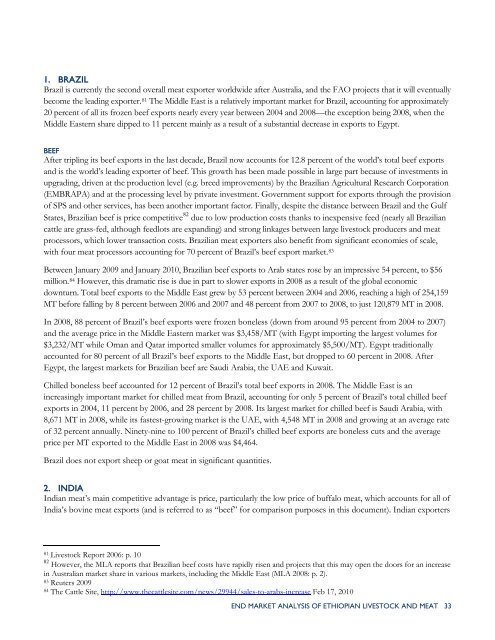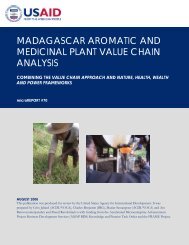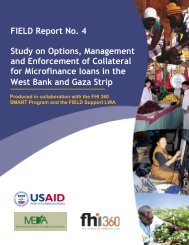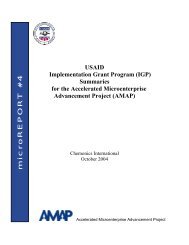End Market Analysis of Ethiopian Livestock and ... - USAID Microlinks
End Market Analysis of Ethiopian Livestock and ... - USAID Microlinks
End Market Analysis of Ethiopian Livestock and ... - USAID Microlinks
You also want an ePaper? Increase the reach of your titles
YUMPU automatically turns print PDFs into web optimized ePapers that Google loves.
1. BRAZIL<br />
Brazil is currently the second overall meat exporter worldwide after Australia, <strong>and</strong> the FAO projects that it will eventually<br />
become the leading exporter. 81 The Middle East is a relatively important market for Brazil, accounting for approximately<br />
20 percent <strong>of</strong> all its frozen beef exports nearly every year between 2004 <strong>and</strong> 2008—the exception being 2008, when the<br />
Middle Eastern share dipped to 11 percent mainly as a result <strong>of</strong> a substantial decrease in exports to Egypt.<br />
BEEF<br />
After tripling its beef exports in the last decade, Brazil now accounts for 12.8 percent <strong>of</strong> the world’s total beef exports<br />
<strong>and</strong> is the world’s leading exporter <strong>of</strong> beef. This growth has been made possible in large part because <strong>of</strong> investments in<br />
upgrading, driven at the production level (e.g. breed improvements) by the Brazilian Agricultural Research Corporation<br />
(EMBRAPA) <strong>and</strong> at the processing level by private investment. Government support for exports through the provision<br />
<strong>of</strong> SPS <strong>and</strong> other services, has been another important factor. Finally, despite the distance between Brazil <strong>and</strong> the Gulf<br />
States, Brazilian beef is price competitive 82 due to low production costs thanks to inexpensive feed (nearly all Brazilian<br />
cattle are grass-fed, although feedlots are exp<strong>and</strong>ing) <strong>and</strong> strong linkages between large livestock producers <strong>and</strong> meat<br />
processors, which lower transaction costs. Brazilian meat exporters also benefit from significant economies <strong>of</strong> scale,<br />
with four meat processors accounting for 70 percent <strong>of</strong> Brazil’s beef export market. 83<br />
Between January 2009 <strong>and</strong> January 2010, Brazilian beef exports to Arab states rose by an impressive 54 percent, to $56<br />
million. 84 However, this dramatic rise is due in part to slower exports in 2008 as a result <strong>of</strong> the global economic<br />
downturn. Total beef exports to the Middle East grew by 53 percent between 2004 <strong>and</strong> 2006, reaching a high <strong>of</strong> 254,159<br />
MT before falling by 8 percent between 2006 <strong>and</strong> 2007 <strong>and</strong> 48 percent from 2007 to 2008, to just 120,879 MT in 2008.<br />
In 2008, 88 percent <strong>of</strong> Brazil’s beef exports were frozen boneless (down from around 95 percent from 2004 to 2007)<br />
<strong>and</strong> the average price in the Middle Eastern market was $3,458/MT (with Egypt importing the largest volumes for<br />
$3,232/MT while Oman <strong>and</strong> Qatar imported smaller volumes for approximately $5,500/MT). Egypt traditionally<br />
accounted for 80 percent <strong>of</strong> all Brazil’s beef exports to the Middle East, but dropped to 60 percent in 2008. After<br />
Egypt, the largest markets for Brazilian beef are Saudi Arabia, the UAE <strong>and</strong> Kuwait.<br />
Chilled boneless beef accounted for 12 percent <strong>of</strong> Brazil’s total beef exports in 2008. The Middle East is an<br />
increasingly important market for chilled meat from Brazil, accounting for only 5 percent <strong>of</strong> Brazil’s total chilled beef<br />
exports in 2004, 11 percent by 2006, <strong>and</strong> 28 percent by 2008. Its largest market for chilled beef is Saudi Arabia, with<br />
8,671 MT in 2008, while its fastest-growing market is the UAE, with 4,548 MT in 2008 <strong>and</strong> growing at an average rate<br />
<strong>of</strong> 32 percent annually. Ninety-nine to 100 percent <strong>of</strong> Brazil’s chilled beef exports are boneless cuts <strong>and</strong> the average<br />
price per MT exported to the Middle East in 2008 was $4,464.<br />
Brazil does not export sheep or goat meat in significant quantities.<br />
2. INDIA<br />
Indian meat’s main competitive advantage is price, particularly the low price <strong>of</strong> buffalo meat, which accounts for all <strong>of</strong><br />
India’s bovine meat exports (<strong>and</strong> is referred to as “beef” for comparison purposes in this document). Indian exporters<br />
81 <strong>Livestock</strong> Report 2006: p. 10<br />
82 However, the MLA reports that Brazilian beef costs have rapidly risen <strong>and</strong> projects that this may open the doors for an increase<br />
in Australian market share in various markets, including the Middle East (MLA 2008: p. 2).<br />
83 Reuters 2009<br />
84 The Cattle Site, http://www.thecattlesite.com/news/29944/sales-to-arabs-increase Feb 17, 2010<br />
END MARKET ANALYSIS OF ETHIOPIAN LIVESTOCK AND MEAT 33





